
views
Understanding the Basics

Consider the ways to end a marriage or registered domestic partnership. The three main ways in California are legal separation, divorce, and annulment. One method may be more appropriate to your situation than the other two. Divorce, or dissolution, legally ends a marriage or domestic partnership and divides the couple's property. The parties are legally considered to be single and can enter into another marriage or domestic partnership. Couples who have been married or registered domestic partners for less than five years, have no children together, and have few assets and debts, can file for Summary Dissolution, which permits you to divorce by filing a few forms without having to attend a hearing. In other cases, couples wishing to divorce must file for a Regular Dissolution. After a divorce petition is filed, there is a mandatory 6-month waiting period before the divorce can be finalized. Legal separation does not end a marriage or domestic partnership. It only permits the couple to legally separate their finances, debts , and property. After a legal separation, the parties are not legally considered to be single, and cannot remarry or enter a new domestic partnership. One party must live in California in the county in which the petition is filed. There is no length of residency requirement. Annulment is the process by which the court determines that the marriage or domestic partnership is invalid. Reasons for invalidity include: The relationship is incestuous The relationship was entered due to force, fraud, or physical or mental incapacity One spouse or partner was too young to marry or enter a domestic partnership One spouse or partner was already married or in a domestic partnership

Determine the proper county in which to file your separation. A Petition for Legal Separation must be filed in the California county where at least one party currently resides. If you are unsure what county to file in, you can use the county selection program provided by the California courts.

Understand community property law. California is a community property state, which means that property acquired during marriage belongs the community (meaning that it is equally owned by both parties in the marriage or partnership). When preparing your Preliminary Disclosure, you will need to identify each asset and debt and characterize it as a community asset or separate asset. "Community property" refers to any funds or property acquired during the marriage or partnership, or purchased with funds earned during the marriage or partnership. "Separate property" refers to any funds or property acquired prior to marriage or partnership, purchased with funds earned prior to marriage or partnership, or given as a gift or inheritance to one party during the marriage or partnership. Some assets may not fall clearly into one category or the other; for example, a home purchased with a separate property funds where the mortgage was paid with community funds. Such assets will be divided according to the percentage of their value attributable to the community.
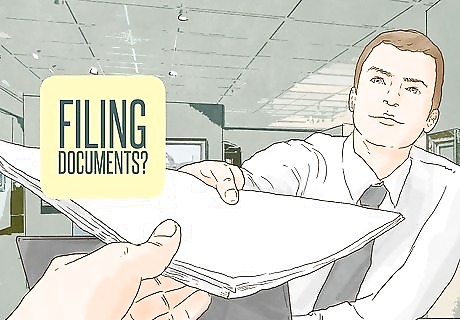
Understand how to file court documents. Make two (2) copies of each form; one copy for the other party and one copy for your own records. You will be filing the original with the court. Take your original forms, copies, and the filing fee payment to the clerk’s office. The clerk will file your paperwork and stamp your copies as "filed." California's statewide fee schedule is available here. The fee to file a Petition for Legal Separation or a Response is $435 (the fee may vary in Riverside, San Bernardino, and San Francisco counties).
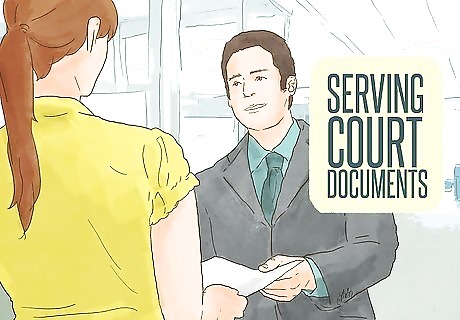
Understand how to serve documents. Once you have filed your documents, you will need to serve the other party with copies of the paperwork stamped as "filed" by the court clerk. To serve the other party, anyone 18 years of age or older can mail the paperwork to the other party or deliver the paperwork to the other party in person. You cannot serve the other party yourself. The Petition for Legal Separation and its related documents must be served to the Respondent in person, not by mail. All other documents served after can be served by mail or in person. You may have a friend or family member, the sheriff's department, or a professional process server serve the Petitioner. Professional process servers and the sheriff’s department charge a fee for service. Have your process server serve copies of everything you filed with the court (except for a Fee Waiver, if any) Have your process server fill out a Proof of Service by Mail or a Proof of Personal Service for you to file with the court. By signing this form, the process server verifies that he or she actually served the documents on the Petitioner. Read the Information Sheet For Proof of Service By Mail (FL-335-INFO) for more information on completing an FL-335. Read the Information Sheet For Proof of Personal Service (FL-330-INFO) for more information on completing an FL-330. File the Proof of Service. Bring the Proof of Service of Summons and/or Proof of Service by Mail filled out by your process server to the court clerk. The clerk will file your forms. There is no fee to file a proof of service.
Filing a Petition for Legal Separation
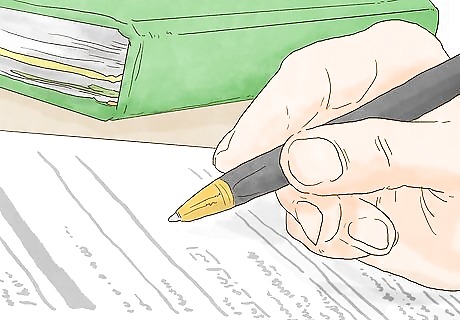
Fill out a Petition for Legal Separation. This form, numbered FL-100, tells the court why you want a legal separation and briefly identifies the issues the court will need to address, including child custody, child and spousal support, and property division. You can download an FL-100 here.

Fill out a Summons. This form, numbered FL-110, gives notice to the other party that you have filed a Petition for Legal Separation. The party filing the petition is the "Petitioner," and the party responding to the petition is the "Respondent." The form informs the Respondent that he or she has 30 days to file a response to the petition, or else a default judgment may be entered against him or her. You can download an FL-110 here. Read this form carefully, as it contains some basic restraining orders limiting what the parties can do with marital debts and assets and residency of any children of the parties while the separation is pending.
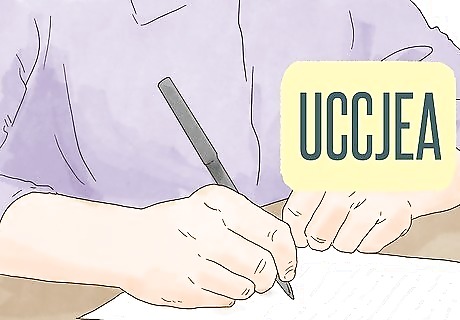
Fill out a Declaration Under Uniform Child Custody Jurisdiction and Enforcement Act (UCCJEA) only if you have any minor children with the other party. This form, number FL-105, informs the court of where any children are living and whether they are involved in other court cases. You can download an FL-105 here.
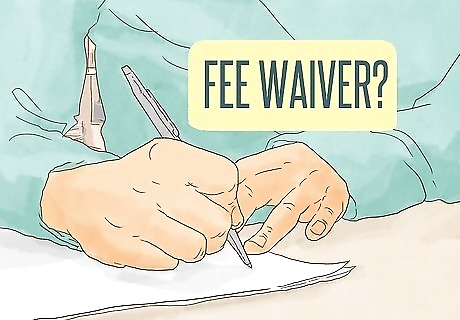
Fill out a Fee Waiver if you cannot afford to pay the filing fee. California's statewide fee schedule is available here. The fee to file a Petition for Legal Separation is $435 (the fee may vary in Riverside, San Bernardino, and San Francisco counties). If you are low-income and cannot afford to pay the filing fee, you can file a request for a fee waiver, numbered FW-001. You can download an FW-001 here. You may qualify for a waiver if you are receiving public benefits, if your household income falls below a specified threshold, or if the court finds that you do not have enough money to pay for both your household's basic needs and the court fees. Be sure to read the Information Sheet on Waiver of Superior Court Fees and Costs (FW-001-INFO)
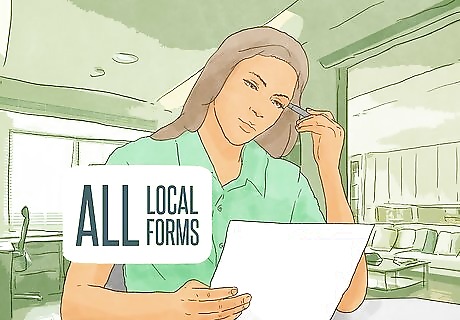
Fill out any required local forms. Some counties require additional local forms for a legal separation. Check with your Family Law Facilitator or your county court’s website. You can locate your county court’s website by selecting your county on the California court’s Find My Court webpage.

File your forms with the court and have them served on the other party. If you are applying for a Fee Waiver, make only one copy of your FW-001 form. You will be filing the original form and keeping the copy for your own records. The FW-001 is confidential and should not be served on the other party. Have your server serve all of the following documents: Copies of everything you filed with the court (except for a Fee Waiver, if any) A blank Response form A blank Declaration Under Uniform Child Custody Jurisdiction and Enforcement Act (UCCJEA), if you have any minor children with the other party Two (2) copies of the Notice and Acknowledgment of Receipt, if the other party agrees to accept service by mail. If the other party does not fill out the Acknowledgment and file it with the court, you will need to have your server serve him or her again, in person.
Responding to a Petition for Legal Separation (Respondent Only)

Understand the Respondent's options. If you have been served with a summons and petition, you are the respondent in a court case for legal separation. The Respondent has several options: Do nothing. If the Respondent does not file a response within 30 days of being served, then the court will probably grant everything the Petitioner requested in the Petition for Legal Separation, including property division, support, and child custody and visitation. Make a written and notarized agreement. Instead of the Respondent filing a response to the Petition for Legal Separation, the parties can write an agreement, sign it, and have it notarized. The agreement should state that the parties agree to end the marriage or domestic partnership, and specify how the parties would like to divide their property, whether anyone will pay spousal support, and what child support, custody, and visitation orders are needed. The California courts provide more information on these agreements here. File a response, but also make a written and notarized agreement. If the Respondent files a response to the Petition for Legal Separation, the parties can still agree to resolve the issues and submit a written and notarized agreement. File a response without an agreement. By filing a response, the Respondent demonstrates that he or she disagrees with the requests that the Petitioner made in the Petition for Legal Separation. Any response must be filed within 30 days of the date that the Respondent was served with the Summons and Petition.
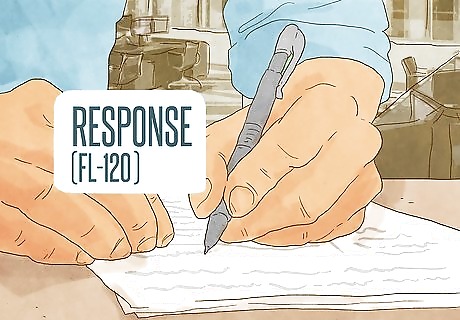
Fill out a Response. This form, numbered FL-120, briefly identifies the issues the Respondent wants the court to address, including child custody, child and spousal support, and property division. You can download an FL-120 here. If you need help completing this form, read these instructions provided by the California courts.

Fill out a Declaration Under Uniform Child Custody Jurisdiction and Enforcement Act (UCCJEA) only if you have any minor children with the Petitioner. This form, numbered FL-105, informs the court of where any children are living and whether they are involved in other court cases. You can download an FL-105 here.

Fill out a Fee Waiver if you cannot afford to pay the filing fee. The process and standards for applying for a fee waiver as a respondent are the same as those used for the petitioner.
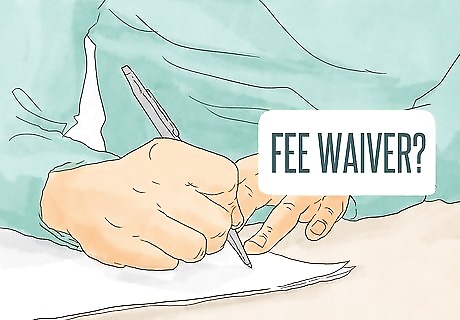
Fill out any required local forms. Some counties require respondents to file additional local forms for a legal separation, which may differ from those required of the petitioner. Check with your Family Law Facilitator or your county court’s website. You can locate your county court’s website by selecting your county on the California court’s Find My Court webpage.
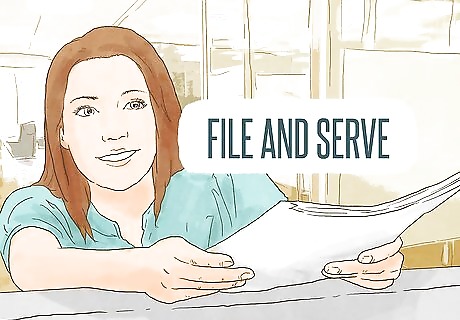
File your forms with the court and have them served on the other party. If you are applying for a Fee Waiver, do not serve it on the other party.
Preparing Preliminary and Final Disclosures
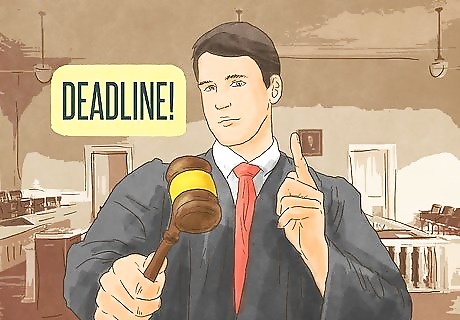
Understand the deadlines. After you file a Petition for Legal Separation, you must serve a Preliminary Disclosure disclosing all of your property and assets within 60 days. The other party has 30 days from the date he or she was served with the Petition to file a response. Then the other party has an additional 60 days from the date he or she filed the response to serve his or her own Preliminary Disclosure. A Final Disclosure from both parties must be served before the separation is finalized, unless the parties agree to waive Final Declarations. The Petitioner is required to file a Preliminary Disclosure even if the other party never responds to the Petition for Legal Separation.
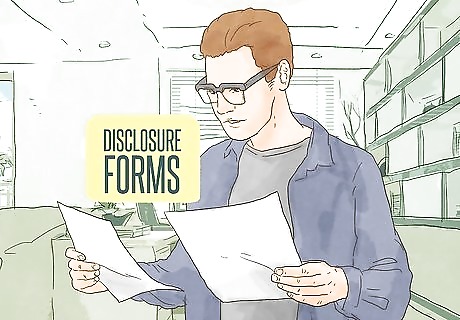
Fill out a Declaration of Disclosure. This form, numbered FL-140, is a combination of instructions, checklist, and cover sheet for your other disclosure documents. You can download an FL-140 here. The form requires you to verify that you have attached the following: Either a Schedule of Assets and Debts (FL-142) or Property Declaration (FL-160) Income and Expense Declaration (FL-150) Copies of all tax returns you filed in the last two years A separate sheet of paper (not a court form) with your case name and case number at the top that includes: A statement explaining how you came up with your estimated value of all assets that are all or partly community property A statement listing values of the assets and debts that you and your spouse or domestic partner may be liable for A list of your investment opportunities since you separated
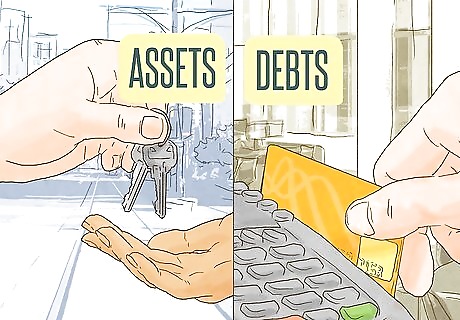
Fill out a Schedule of Assets and Debts (unless you will fill out a Property Declaration instead). This form, numbered FL-142, lists all of the parties' assets and debts and permits you to propose how each assets and debt will be divided between the parties. Compare the FL-142 with the FL-160 and complete the form that makes the most sense for your situation. Ordinarily, the community property will be divided equally between the parties, and each party is entitled to keep his or her separate property. You can download an FL-142 here.

Fill out a Property Declaration (unless you filled out a Schedule of Assets and Debts instead). This form, numbered FL-160, lists all of the parties' assets and debts and permits you to propose how each asset and debt will be divided between the parties. Compare the FL-160 with the FL-142 and complete the form that makes the most sense for your situation. You can download an FL-160 here.
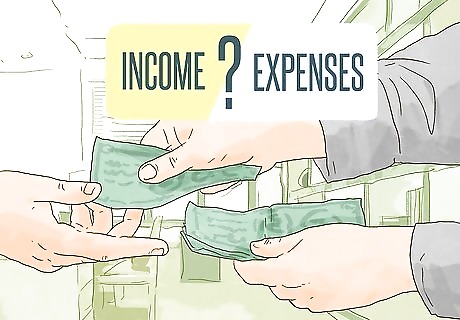
Fill out an Income and Expense Declaration. This form, numbered FL-150, requires you to disclose your income, expenses, and earning capacity. You can download an FL-150 here. You must attach copies of your pay stubs for the last two months. Black out any social security numbers.

Serve your documents and file a Declaration Regarding Service of Declaration of Disclosure and Income and Expense Declaration. Make one copy of each form. The copy is for the other party. Keep the original for your own records. You will not be filing these documents with the court. Filed documents are public record, but your financial information is confidential.

Have your process server fill out a Declaration Regarding Service of Declaration of Disclosure and Income and Expense Declaration. By signing and filing this form, the process server verifies that your documents were served on the other party. File the Declaration Regarding Service of Declaration of Disclosure and Income and Expense Declaration.

Determine whether a Final Disclosure is necessary. A Final Disclosure is just like a Preliminary Disclosure. Final Disclosures from both parties must be served before the separation is finalized, unless the parties agree to waive Final Declarations, or if the Respondent never files a response and no agreement between the parties is reached. To waive the Final Disclosure, fill out a Stipulation and Waiver of Final Declaration of Disclosure (FL-144), or state your wish to waive the Final Disclosure in a written and notarized agreement between the parties.

Complete the Final Disclosure. If you are required to complete a Final Disclosure in your case, follow the same processes you used to fill out, file, serve, file proof of service for your Preliminary Disclosure.
Finalizing Your Separation When the Respondent Did Not File a Response Within 30 Days

Fill out the mandatory forms. These forms are used to ask the court to enter a default judgment against the Respondent. The mandatory forms are: Request to Enter Default (FL-165) Declaration for Default or Uncontested Dissolution (FL-170) Judgment (FL-180) Notice of Entry of Judgment (FL-190)

Fill out child custody forms. You can fill out any of the forms that may apply to your case. Attach the forms to your Judgment (FL-180). The child custody forms are: Child Custody and Visitation Order Attachment (FL-341) Supervised Visitation Order (FL-341A) Child Abduction Prevention Order Attachment (FL-341B) Children's Holiday Schedule Attachment (FL-341C) Additional Provisions -- Physical Custody Attachment (FL-341D) Joint Legal Custody Attachment (FL-341E)

Fill out child support forms. If you want to request child support payments from the other party, you can fill out any of the forms that may apply to your case. Attach the forms to your Judgment (FL-180). The child support forms are: Child Support Information and Order Attachment (FL-342) Income and Expense Declaration (FL-150) or Financial Statement (FL-155) Child Support Case Registry Form (FL-191) Notice of Rights and Responsibilities - Health Care Costs and Reimbursement Procedures and Information Sheet on Changing a Child Support Order (FL-192) (there is nothing to fill out on this form, but it should be read carefully) Income Withholding for Support (FL-195) See Income Withholding for Support - Instructions (FL-196) for more information. When filing out an FL-195, only write the last 4 digits of the social security number of the person ordered to pay support to protect his or her privacy.
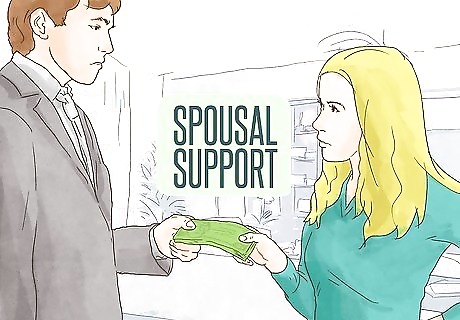
Fill out spousal or partner support forms. If you want to request support payments from the other party, you can fill out any of the forms that may apply to your case. Attach the forms to your Judgment (FL-180). The support forms are: Spousal or Partner Support Declaration Attachment (FL-157) Spousal, Partner, or Family Support Order Attachment (FL-343) Income and Expense Declaration (FL-150) Earnings Assignment Order for Spousal or Partner Support (FL-435) Only use the FL-435 if you are not asking for child support. If you are asking for both child and spousal or partner support, fill out an FL-195. When filing out a FL-435 or FL-195, only write the last 4 digits of the social security number of the person ordered to pay support to protect his or her privacy.
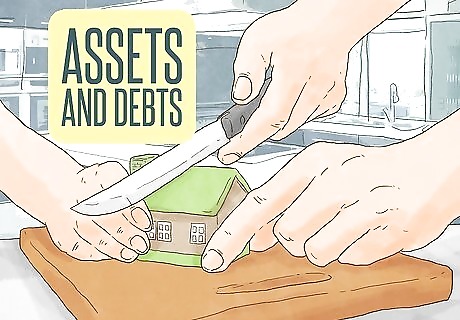
Fill out asset and debt division forms. If you want the court to divide your community assets and debts, you can fill out any of the forms that may apply to your case. Attach the forms to your Judgment (FL-180). The asset and debt division forms are: Property Order Attachment to Judgment (FL-345) Property Declaration (FL-160) Pension Benefits - Attachment to Judgment (FL-348) Read Retirement Plan Joinder - Information Sheet (FL-318-INFO) for more information on pension plans.
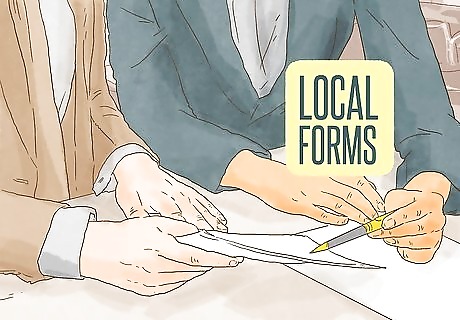
Fill out any required local forms. Some counties require additional local forms for a legal separation. Check with your Family Law Facilitator or your county court’s website. You can locate your county court’s website by selecting your county on the California court’s Find My Court webpage.

File your forms with the court. Bring two large envelopes with postage. The clerk may require you to provide envelopes and postage to save the cost of mailing the final judgment. If there is a problem with the documents, a court appearance may be necessary, or you may be asked to fix the mistakes in your paperwork. If your documents are completed correctly, the judge will sign the Judgment without either party having to appear in court.
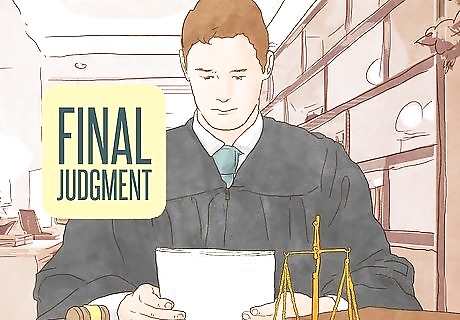
Wait to receive your final judgment. A clerk will mail the Judgment and Notice of Entry of Judgment to each spouse or domestic partner. Keep a copy of these forms for your records. You are legally separated as of the date the judgment was signed.
Finalizing Your Separation When the Parties Have An Agreement

Fill out the mandatory forms. These forms are required to enter a default judgment or uncontested dissolution of the marriage or partnership. This process is the same whether or not the Respondent filed a response within 30 days, as long as there is a signed and notarized agreement between the parties. The mandatory forms are: Request to Enter Default (FL-165) or Appearance, Stipulations, and Waivers (FL-130) If the Respondent cannot afford the filing fee, he or she can request a fee waiver by filing an FW-001. Declaration for Default or Uncontested Dissolution (FL-170) Judgment (FL-180) Notice of Entry of Judgment (FL-190) A written and notarized agreement. The agreement should state that the parties agree to end the marriage or domestic partnership, and specify how the parties would like to divide their property, whether anyone will pay spousal support, and what child support, custody, and visitation orders are needed. The California courts provide more information on these agreements here. If you have not yet filed a final Declaration Regarding Service of Disclosure (FL-141) or a Stipulation and Waiver of Final Declaration of Disclosure (FL-144), do fill one now.

Fill out child custody forms. You can fill out any of the forms that may apply to your case. Attach the forms to your Judgment (FL-180). The child custody forms are: Child Custody and Visitation Order Attachment (FL-341) Supervised Visitation Order (FL-341A) Child Abduction Prevention Order Attachment (FL-341B) Children's Holiday Schedule Attachment (FL-341C) Additional Provisions -- Physical Custody Attachment (FL-341D) Joint Legal Custody Attachment (FL-341E)

Fill out child support forms. If you want to request child support payments from the other party, you can fill out any of the forms that may apply to your case. Attach the forms to your Judgment (FL-180). The child support forms are: Child Support Information and Order Attachment (FL-342) Income and Expense Declaration (FL-150) or Financial Statement (FL-155) Child Support Case Registry Form (FL-191) Notice of Rights and Responsibilities - Health Care Costs and Reimbursement Procedures and Information Sheet on Changing a Child Support Order (FL-192) (there is nothing to fill out on this form, but it should be read carefully) Income Withholding for Support (FL-195) See Income Withholding for Support - Instructions (FL-196) for more information. When filing out an FL-195, only write the last 4 digits of the social security number of the person ordered to pay support to protect his or her privacy.
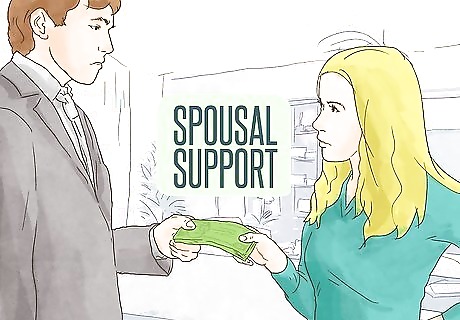
Fill out spousal or partner support forms. If you want to request support payments from the other party, you can fill out any of the forms that may apply to your case. Attach the forms to your Judgment (FL-180). The support forms are: Spousal, Partner, or Family Support Order Attachment (FL-343) Income and Expense Declaration (FL-150) Earnings Assignment Order for Spousal or Partner Support (FL-435) Only use the FL-435 if you are not asking for child support. If you are asking for both child and spousal or partner support, fill out an FL-195. When filing out a FL-435 or FL-195, only write the last 4 digits of the social security number of the person ordered to pay support to protect his or her privacy.

Fill out asset and debt division forms. If you want the court to divide your community assets and debts, you can fill out any of the forms that may apply to your case. Attach the forms to your Judgment (FL-180). The asset and debt division forms are: Property Order Attachment to Judgment (FL-345) Property Declaration (FL-160) Pension Benefits - Attachment to Judgment (FL-348) Read Retirement Plan Joinder - Information Sheet (FL-318-INFO) for more information on pension plans.

Fill out any required local forms. Some counties require additional local forms for a legal separation. Check with your Family Law Facilitator or your county court’s website. You can locate your county court’s website by selecting your county on the California court’s Find My Court webpage.
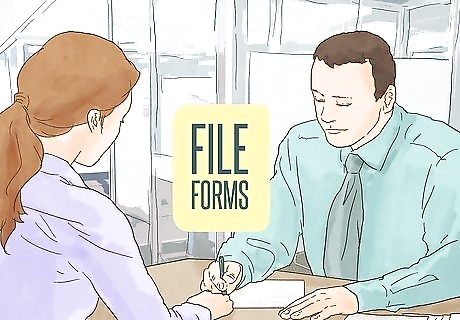
File your forms with the court. Bring two large envelopes with postage. The clerk may require you to provide envelopes and postage to save the cost of mailing the final judgment. If there is a problem with the documents, a court appearance may be necessary, or you may be asked to fix the mistakes in your paperwork. If your documents are completed correctly, the judge will sign the Judgment without either party having to appear in court.

Wait to receive your final judgment. A clerk will mail the Judgment and Notice of Entry of Judgment to each spouse or domestic partner. Keep a copy of these forms for your records. You are legally separated as of the date the judgment was signed.
Finalizing Your Separation When the Respondent Filed a Response and There Is No Agreement Between the Parties

Consider your options. If the parties disagree about how to resolve the issues of asset and debt division, child custody, child support, and/or spousal or partner support, a trial will be necessary. At the trial, the judge will hear testimony and examine evidence before deciding how to resolve the issues. If you want to avoid a trial, a professional mediator may be able to help the parties agree on how to resolve any outstanding issues.

Consider mediation. If you and the other party want a professional mediator to help settle the outstanding issues, contact the court clerk and ask if there are any mediation programs available. You can also contact your local Family Law Facilitator or self-help center.

Request a trial. If you and the other party cannot reach an agreement and require a court trial to resolve the outstanding issues, one party must file and serve a form to set a trial date. Ask the court clerk what steps to take and which forms to fill out. Most courts require the parties to attend a settlement conference before trial. If your court requires you to attend a settlement conference, the judge will give you further instructions. After the trial, the court will enter a judgment that the parties are legally separated. You may be instructed to file additional paperwork or serve additional paperwork to the other party.

















Comments
0 comment